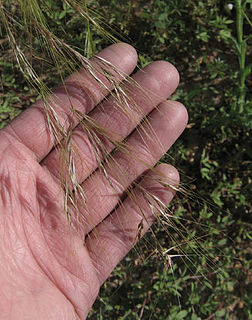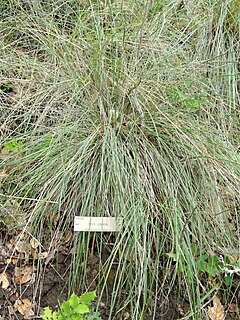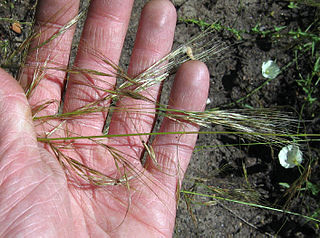
Nassella, or needlegrass, is a New World genus of over 100 perennial bunchgrasses found from North America through South America. The Latin word nassa refers to "a basket with a narrow neck". It is usually considered segregate from the genus Stipa and includes many New World species formerly classified in that genus. As of 2011, The Jepson Manual includes Nassella within Stipa.

Nassella pulchra, basionym Stipa pulchra, is a species of grass known by the common names purple needlegrass and purple tussockgrass. It is native to the U.S. state of California, where it occurs throughout the coastal hills, valleys, and mountain ranges, as well as the Sacramento Valley and parts of the Sierra Nevada foothills, and Baja California.

Festuca idahoensis is a species of grass known by the common names Idaho fescue and blue bunchgrass. It is native to western North America, where it is widespread and common. It can be found in many ecosystems, from shady forests to open plains grasslands.

Tussock grasses or bunch grasses are a group of grass species in the family Poaceae. They usually grow as singular plants in clumps, tufts, hummocks, or bunches, rather than forming a sod or lawn, in meadows, grasslands, and prairies. As perennial plants, most species live more than one season. Tussock grasses are often found as forage in pastures and ornamental grasses in gardens.

Achnatherum aridum is a species of grass known by the common name Mormon needlegrass. It is native to the southwestern United States from the Mojave Desert in California east to Colorado and New Mexico.

Stipa coronata, formerly classified as Achnatherum coronatum, is a greenish species of grass known by the common name crested needlegrass, giant ricegrass, and giant stipa.

Achnatherum latiglume is a species of grass known by the common names wide-glumed needlegrass and Sierra needlegrass.

Achnatherum lettermanii is a species of grass known by the common name Letterman's needlegrass. The updated and accepted name is Stipa lettermanii. It is native to the western United States from California to Montana to New Mexico, where it is a resident of several types of habitat.

Achnatherum occidentale is a species of grass known by the common name western needlegrass. It is native to western North America from British Columbia to California to Colorado, where it grows in many types of habitat. This is a tufting perennial bunchgrass forming tight clumps of erect stems up to about 120 centimetres (47 in) in maximum height, but sometimes much shorter. The hairlike leaves are less than a millimeter wide and may have rolled edges. The inflorescence is up to 30 centimetres (12 in) long, with each hairy spikelet bearing an awn up to 4 or 5 centimeters long. The awn is kinked twice.

Stipa parishii, formerly classified as Achnatherum parishii, is a species of grass known by the common name Parish's needlegrass. The Jepson Manual 2nd edition (2012) reclassified the plant as Stipa parishii var. parishii.

Achnatherum pinetorum is a species of grass known by the common names pinewoods needlegrass and pine needlegrass. It is native to most of the western United States from California to Montana to New Mexico, where it grows in woodland and forest in rocky mountainous areas.

Stipa speciosa (syn. Achnatherum speciosum is a species of grass known by the common name desert needlegrass. It is native to much of the south-western United States from California to Colorado, where it grows in dry areas, especially sagebrush habitat. It is also known from Mexico and parts of South America.

Ehrharta calycina is a species of grass known by the common names perennial veldtgrass and purple veldtgrass.

Melica imperfecta is a species of grass known by the common name smallflower melic and little California melic.
Stipa avenacea - renamed Piptochaetium avenaceum, and commonly called black oat grass, blackseed needle grass or blackseed speargrass, is a perennial bunchgrass native to Eastern North America. It is a member of the grass family Poaceae.

Hesperostipa spartea, formerly Stipa spartea, is a species of grass known by the common names porcupine grass, western porcupine grass, short-awn porcupine grass, porcupine needlegrass, and big needlegrass. It is native to North America, where it is widespread from British Columbia to Ontario in Canada and through the central and Great Lakes regions of the United States. It is a bunchgrass species in the genus Hesperostipa.

Nassella viridula is a species of grass known by the common name green needlegrass. It is native to North America, where it is widespread in western Canada and the western and central United States. It is introduced in parts of eastern North America.

Stipa lemmonii is a species of grass known by the common name Lemmon's needlegrass. It is native to western North America, where its distribution extends from British Columbia to southern California.

Nassella leucotricha is a species of grass known by the common names Texas wintergrass, Texas needlegrass, and Texas tussockgrass. It is native to the south-central United States and much of Mexico.

Nassella lepida is a species of grass known by the common names foothill needlegrass, foothills nassella, foothill stipa, small-flowered stipa, small-flowered needlegrass, and smallflower tussockgrass.




















